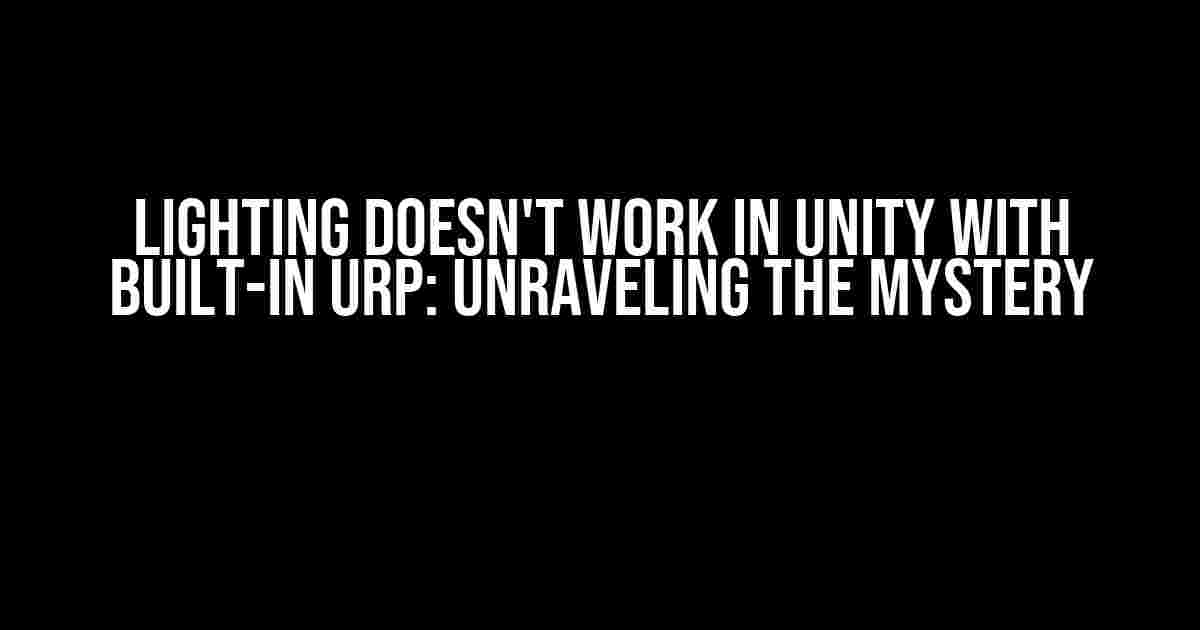Are you tired of struggling with lighting in Unity using the built-in Universal Render Pipeline (URP)? You’re not alone! Many developers have encountered this issue, and it’s time to shed some light (pun intended) on the matter. In this comprehensive guide, we’ll delve into the common causes, troubleshooting steps, and expert-level solutions to get your lighting working like a charm.
The Symptoms
Before we dive into the fix, let’s identify the symptoms. If you’re experiencing any of the following, you’re in the right place:
- Light sources are not emitting light
- Shadows are not being cast
- Lighting looks incorrect or inconsistent
- Scene is too bright or too dark
Common Causes
Now that we’ve established the symptoms, let’s explore the most common causes of lighting issues in Unity with URP:
-
Incorrect Lighting Settings
URP uses a different lighting model than the built-in renderer. Make sure you’re using the correct settings for your lighting setup.
-
Missing or Incorrectly Configured Light Sources
Double-check that your light sources are properly set up, and their properties are correctly configured.
-
Incorrect Shader or Material Settings
URP-compatible shaders and materials are essential for proper lighting. Ensure you’re using the correct ones for your project.
-
Scene Hierarchy Issues
A cluttered or disorganized scene hierarchy can cause lighting issues. Keep your scene organized, and avoid unnecessary nesting.
Troubleshooting Steps
Before we dive into the advanced solutions, let’s try some basic troubleshooting steps:
-
Check the Unity Version
Ensure you’re running the latest version of Unity, as older versions might have known lighting issues.
-
Verify Lighting Settings
Check the Lighting window (Window > Lighting > Settings) to ensure the correct settings are applied.
-
Light Source Inspection
Inspect each light source, checking its type, range, and intensity. Adjust as needed.
-
Shader and Material Review
Review your shaders and materials, ensuring they’re URP-compatible and correctly configured.
-
Scene Hierarchy Clean-up
Organize your scene hierarchy, removing unnecessary objects and simplifying the structure.
Advanced Solutions
If the troubleshooting steps didn’t resolve the issue, it’s time to dive deeper:
LWRP and URP-Built-In Compatibility
If you’re using LWRP (Lightweight Render Pipeline) assets in a URP project, you might encounter compatibility issues. Try the following:
// Convert LWRP assets to URP-compatible assets
using UnityEngine.Rendering.Universal;
public class LWRPtoURPConverter : ScriptableRendererFeature
{
[System.Serializable]
public class LWRPtoURPConversionPass : ScriptableRenderPass
{
// ...
}
}
Custom Lighting Shaders
Create a custom lighting shader to bypass URP’s built-in limitations. Here’s an example:
Shader "Custom/LightingShader"
{
Properties
{
_MainTex ("Albedo (RGBA)", 2D) = "white" {}
_MetallicGlossMap ("Metallic Gloss Map", 2D) = "white" {}
_BumpMap ("Normal Map", 2D) = "bump" {}
}
SubShader
{
Tags {"Queue"="Transparent" "RenderType"="Transparent"}
LOD 200
CGPROGRAM
#pragma surface surf Lambert
struct Input
{
float2 uv_MainTex;
};
sampler2D _MainTex;
sampler2D _MetallicGlossMap;
sampler2D _BumpMap;
void surf (Input IN, inout SurfaceOutput o)
{
fixed4 col = tex2D(_MainTex, IN.uv_MainTex) * _Color;
o.Albedo = col.rgb;
o.Alpha = col.a;
o.Normal = UnpackNormal(tex2D(_BumpMap, IN.uv_MainTex));
return;
}
ENDCG
}
FallBack "Diffuse"
}
Scene-Specific Solutions
In some cases, scene-specific solutions are necessary:
| Issue | Solution |
|---|---|
| Shadows cast incorrectly | Adjust the light source’s shadow distance and bias |
| Lighting looks inconsistent | Check object orientations, and ensure correct Light Probe Group assignments |
| Scene is too bright or too dark | Adjust the Lighting window’s exposure and intensity settings |
Conclusion
Lighting doesn’t work in Unity with built-in URP? Not anymore! By following this comprehensive guide, you should now have a solid understanding of the common causes, troubleshooting steps, and advanced solutions to get your lighting issues resolved. Remember to stay calm, patient, and methodical in your approach, and don’t hesitate to experiment and try new things.
Happy lighting, and happy coding!
Frequently Asked Question
Having trouble with lighting in Unity using the built-in Universal Render Pipeline (URP)? You’re not alone! Check out these FAQs to get your lighting back on track.
Why doesn’t my lighting work in Unity with URP?
Make sure you’ve assigned a Lightmap Bakery or a Lightprobe Group to your scene. URP relies on these components to bake and simulate lighting. Without them, your lighting won’t work as expected.
I’m using a Mesh Renderer, but my lighting still doesn’t work. What’s the issue?
Double-check that your Mesh Renderer has a Mesh assigned to it, and that the Mesh has a valid UV layout. URP uses UVs to map lightprobe data, so without them, your lighting won’t be applied correctly.
I’m getting weird lighting artifacts with URP. How can I fix them?
Try adjusting your Lightmap Resolution and Light Probe Sample Count in the URP settings. These settings can affect the quality and accuracy of your lighting. You can also experiment with different Lighting Modes, such as Baked Indirect or Realtime, to see what works best for your scene.
Can I use URP with HDRP (High Definition Render Pipeline) lights?
No, URP and HDRP are two separate render pipelines, and they’re not compatible with each other. If you want to use HDRP lights, you’ll need to switch to the HDRP pipeline.
Is there a way to optimize my lighting for better performance in URP?
Yes! You can reduce the number of light probes, use Lightmap Compression, and adjust the Light Probe Sample Count to minimize the performance impact of lighting. Additionally, consider using Baked Lighting instead of Realtime Lighting, especially for static scenes.
